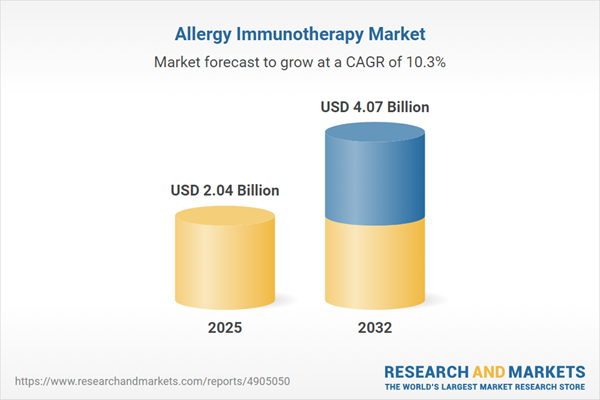Speak directly to the analyst to clarify any post sales queries you may have.
The allergy immunotherapy market is experiencing rapid transformation, driven by advances in treatment modalities, regulatory developments, and the integration of digital health innovations. This report empowers senior decision-makers with the insights required to evaluate market dynamics, emerging technologies, and future strategies for business growth.
Market Snapshot: Allergy Immunotherapy Market Growth and Trends
The Allergy Immunotherapy Market grew from USD 1.86 billion in 2024 to USD 2.04 billion in 2025. It is expected to continue growing at a CAGR of 10.29%, reaching USD 4.07 billion by 2032. The market’s substantial trajectory is attributed to rising allergy prevalence, expanded therapeutic approaches, and evolving global healthcare frameworks. Across regions, stakeholders are addressing increased demand for effective allergy management, enhanced patient experience, and resilience against policy and supply chain shifts.
Scope & Segmentation
- Treatment Types: Epicutaneous immunotherapy, oral immunotherapy, subcutaneous immunotherapy, sublingual immunotherapy
- Allergen Types: Animal dander (cat, dog), dust mites, food allergens (egg, milk, peanut, tree nut), pollen
- Immunotherapy Delivery Forms: Dermal patch, drops, injections, tablets
- Technology Platforms: Adjuvants, nanotechnology-based platforms, recombinant allergens
- Allergy Types: Allergic asthma, allergic rhinitis, atopic dermatitis, urticaria
- End User Environments: Homecare settings, hospitals, research and academic laboratories, specialty clinics
- Distribution Channels: Hospital pharmacy, online pharmacy, retail pharmacy
- Geographic Coverage: Americas (North America and Latin America), Europe, Middle East & Africa (UK, Germany, France, Russia, Italy, Spain, Netherlands, Sweden, Poland, Switzerland, UAE, Saudi Arabia, Qatar, Turkey, Israel, South Africa, Nigeria, Egypt, Kenya), Asia-Pacific (China, India, Japan, Australia, South Korea, Indonesia, Thailand, Malaysia, Singapore, Taiwan)
- Companies Profiled: ALK-Abelló, Allergy Therapeutics, Anergis SA, Biomay AG, BioSpace, F. Hoffmann-La Roche, GlaxoSmithKline, HAL Allergy, Jubilant HollisterStier, Merck KGaA
Key Takeaways for Senior Decision-Makers
- Recent years have seen the therapeutic paradigm shift beyond subcutaneous injections, incorporating patient-centric formulations such as epicutaneous and sublingual options to improve adherence and convenience.
- Technological advances in nanotechnology and engineered allergens enable targeted immune modulation, supporting safer and more durable patient outcomes across multiple allergic conditions.
- Global supply chains are proactively adapting to potential tariff policies and operational uncertainties by diversifying supplier bases, optimizing inventory, and forging resilience through vertical integration.
- Regional strategies are essential; adoption levels, reimbursement frameworks, and healthcare infrastructure maturity differ markedly between North America, Europe, the Middle East, Africa, and Asia-Pacific.
- Digital health platforms and data-driven approaches are increasingly pivotal, facilitating remote monitoring, real-world evidence generation, and enhanced stakeholder collaboration from R&D through commercial deployment.
- Collaborative innovations and strategic alliances between pharmaceutical leaders, specialty clinics, and digital health startups accelerate development pipelines, access, and market entry for novel therapies.
Tariff Impact on Allergy Immunotherapy Supply Chains
Potential tariff changes affecting biopharmaceutical imports have added new complexity to supply chain planning. Companies are responding by seeking domestic sourcing, adopting lean manufacturing, and forming long-term supplier relationships. These actions help stabilize operational costs, maintain consistent therapy availability, and protect ongoing research investments, all while ensuring patients retain access to critical treatments.
Methodology & Data Sources
This report is based on a multi-stage research process, combining exhaustive secondary research with in-depth interviews, data triangulation, and expert validation. Analytical rigor ensures insights are accurate, industry-aligned, and actionable for strategic decision-making.
Why This Report Matters
- Facilitates future-proof market planning by integrating scientific trends, technology adoption, and evolving patient and payer expectations.
- Equips leadership teams with evidence-based insights to navigate regulatory shifts, supply chain disruptions, and regional nuances in allergy treatment access.
Conclusion
The allergy immunotherapy sector is evolving with technological, operational, and strategic advancements redefining therapy delivery and market competition. This report provides the clarity needed to guide investment, innovation, and go-to-market decisions in a rapidly shifting healthcare environment.
Additional Product Information:
- Purchase of this report includes 1 year online access with quarterly updates.
- This report can be updated on request. Please contact our Customer Experience team using the Ask a Question widget on our website.
Table of Contents
3. Executive Summary
4. Market Overview
7. Cumulative Impact of Artificial Intelligence 2025
Companies Mentioned
The companies profiled in this Allergy Immunotherapy market report include:- ALK-Abelló, Inc.
- Allergy Therapeutics PLC
- Anergis SA
- Biomay AG
- BioSpace, Inc.
- F. Hoffmann-La Roche Ltd.
- GlaxoSmithKline plc
- HAL Allergy B.V.
- Jubilant HollisterStier LLC
- Merck KGaA
Table Information
| Report Attribute | Details |
|---|---|
| No. of Pages | 192 |
| Published | November 2025 |
| Forecast Period | 2025 - 2032 |
| Estimated Market Value ( USD | $ 2.04 Billion |
| Forecasted Market Value ( USD | $ 4.07 Billion |
| Compound Annual Growth Rate | 10.2% |
| Regions Covered | Global |
| No. of Companies Mentioned | 11 |









